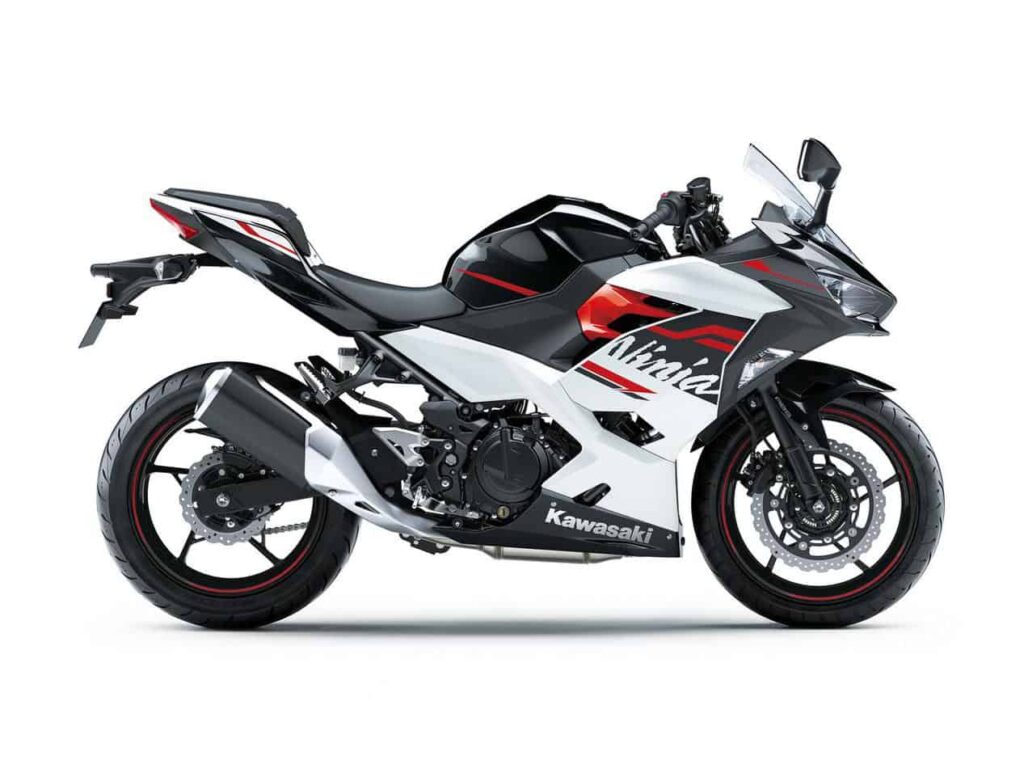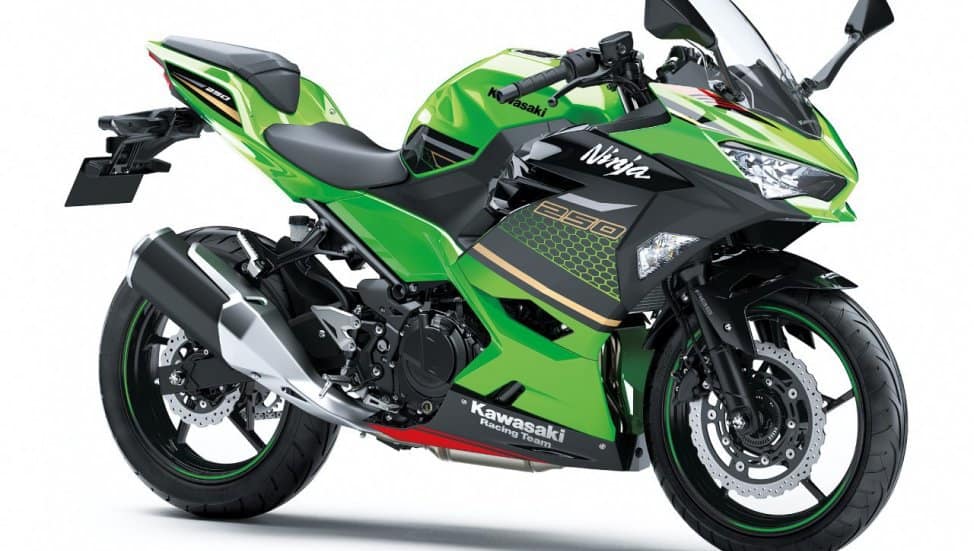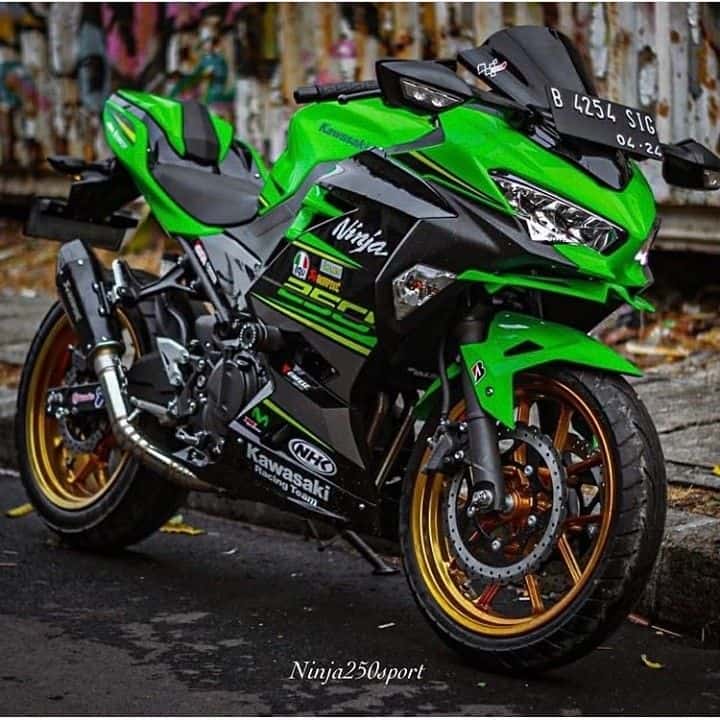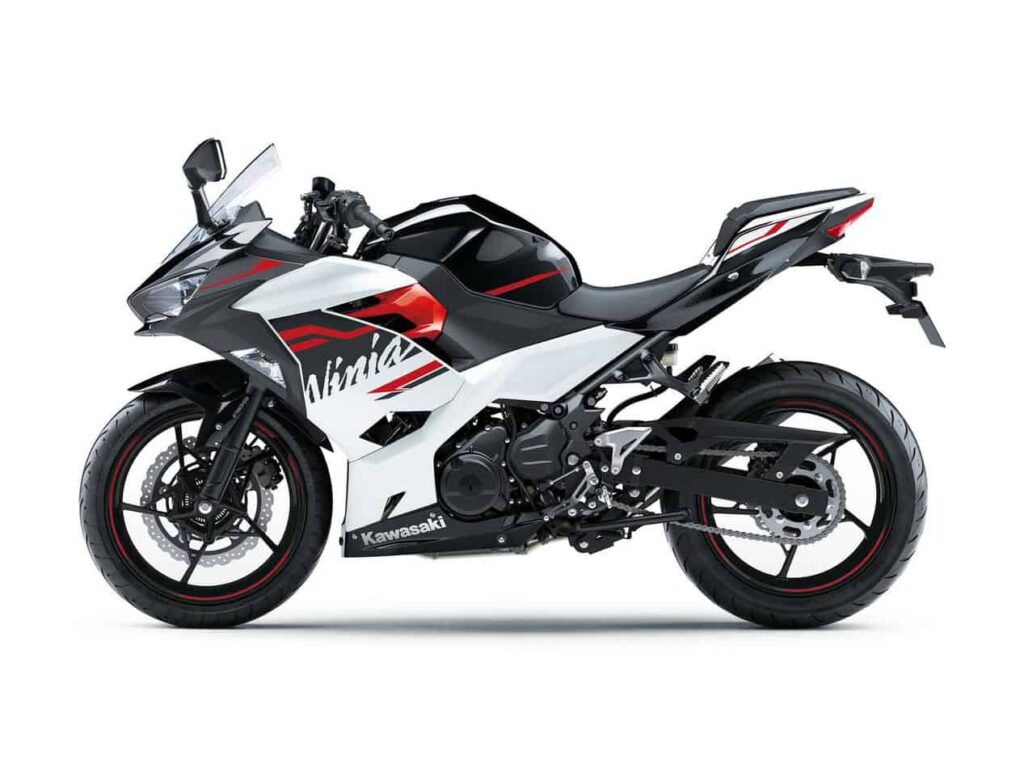Kawasaki Ninja 250 – Lightweight, sharp-looking, high-performance sports model offers excitement and ease of riding to a wide range of customers. Kawasaki proudly introduces a replacement sport model into this highly competitive arena.
Clad in sharp new Ninja styling, the new Ninja 250 delivers greater performance than its predecessor care of all-new engine and chassis that are more powerful and significantly lighter.
But just like the Ninja 300/250 that preceded it, this new Ninja model possesses far more than high performance. The new model takes the winning formula that drove the success of the Ninja 250R and its successors and amplifies it.
Not only does the Ninja 250 offer stunning, but high-quality looks, its stronger engine performance, light, predictable handling, and relaxed, sporty riding position also make it both fun and easy to ride.
Let’s check the equipment of Kawasaki Ninja 250
-
HIGH-CLASS & FUTURISTIC:
Head-turning looks have always been a forte of Ninja models, no matter displacement. The new Kawasaki Ninja 250 boasts futuristic new Ninja styling inspired by the mighty Ninja H2. The large-volume bodywork attracts attention and provides the impression of a bigger machine.
This impression is reinforced by the high-class design and superb fit and finish, which are like bikes from a larger-displacement class. Additionally to contributing to the Ninja 250’s sharper looks,
- Slim LED headlamps (each featuring low and high beams, as well as a LED position lamp) are highly visible and offer significantly increased brightness.
Ninja 250 is using a 249cc, twin-cylinder fuel-injected engine producing 39 HP at 12,500 rpm and 23.5 Nm at 10,000 RPM. The engine comes mated to a 6-speed manual gearbox. The bike weighs almost 6 kg lighter than Ninja 400 and claims almost identical horsepower value to the larger Ninja 300.
-
NOMENCLATURE:
Since 2008, the bike is marketed as the Ninja 250R in all markets. It is also referred to by its platform designation, EX250, to which a generational suffix is attached.
In the United States, previous models (EX250-E/F/G/H) were already being marketed as members of the Ninja family of sport bikes, while outside of the U.S. the bike was known variously as the ZZR-250, ZX-250, or as the GPX-250R. One of the earliest models, the EX250-C, was given the name GPZ-250
-
HIGH PERFORMANCE & HIGH CONTROLLABILITY:
Displacing 249 cm3, the new engine delivers significantly increased performance compared to its predecessor: 27.5 kW for the new Ninja 250 The higher performance can largely be credited to the new downdraft intake, which is accompanied by a larger airbox offering increased intake efficiency.
The increased performance is complemented by a rider-friendly character the smooth response and abundant low-end torque facilitate throttle control for new and experienced riders alike.
-
NEW ASSIST & SLIPPER CLUTCH:
A more compact clutch (ø139 mm >> ø125 mm) with less rigid operating plates offers a 20% lighter lever pull. Complementing the extremely light feel at the lever, the new clutch has a wider engagement range, facilitating control.
-
LIGHTWEIGHT, STABLE & MANOEUVRABLE:
The Ninja 250 features a trellis frame similar in design to that of the Ninja H2. Kawasaki’s advanced dynamic rigidity analysis was used to ensure optimum rigidity with the lightweight. The engine is rigid-mounted and used as a stressed member.
The new frame design contributes significantly to the bike’s low curb mass. Like the Ninja H2, the new Ninja 250 features a Swingarm Mounting Plate. Allowing the swingarm to be affixed to the rear of the engine contributes to the stability and helps with weight savings by eliminating the need for heavy frame cross-members.
-
MORE RIGID FRONT FORK:
A more rigid ø41 mm telescopic fork delivers better suspension action. The front-wheel feels really planted, direction changes are made easily (even when the bike is fairly upright – handy when navigating traffic jams), and overall, the suspension offers the plushness of a larger displacement bike.
-
HIGH-GRADE COCKPIT:
The Kawasaki Ninja 250 is equipped with an equivalent instrument cluster because the Ninja 650, contributes to the high-grade feel of the tidy cockpit. The subtle instrument design features an outsized analog tachometer flanked by warning lamps on one side, and a gear position indicator and multi-function LCD screen on the opposite.
Specification-Information about the Kawasaki Ninja 250 engine
-
ENGINE-POWER-PERFORMANCE:
| Engine type: | Liquid-cooled, 4-stroke, Parallel Twin |
| Displacement: | 249 cc |
| Valve system: | DOHC, 8 valves |
| Bore and stroke: | 62 x 41.2 mm |
| Compression ratio: | 11.6:1 |
| Transmission: | 6-speed, return |
| Ignition: | Digital |
| Fuel system: | Fuel injection: ø32 mm x 2 |
| Starting system: | Electric |
| Clutch: | Wet multi-disc, Manual |
| Tire front: | 110/70-17M/C (54H) |
| Tire rear: | 140/70-17M/C (66H) |
| Length x Width x Height: | 1,990 mm x 710 mm x 1,125 mm |
| Wheelbase: | 1,370 mm |
| Ground clearance: | 145 mm |
| Seat height: | 795 mm |
| Curb mass: | 167 kg |
| Fuel Tank Capacity: | 14 liters |
-
BRAKES-SUSPENSION:
| Brakes: Front: | Single semi-floating ø310 mm petal disc |
| Brakes: Rear: | Single ø220 mm petal disc |
| Suspension: Front | ø41 mm telescopic fork |
| Suspension: Rear | Bottom-link Uni-Trak with gas-charged shock with adjustable preload |
| Caliper: Front | Single balanced actuation dual-piston |
| Caliper: Rear | Dual-piston |
-
QUICK FACTS & INFORMATION:
| Bike Variant: | Kawasaki Ninja 250 |
| Body Type: | Sports |
| Fuel Type: | Petrol |
| Price in India: | New Ninja 250 is expected to be priced around INR 2.75 lakh in India (ex-showroom). |
| Top Speed: | 170+ km/ph |
| Shades: | Lime Green / Ebony (KRT Edition), Metallic Spark Black |
| Official Tagline: | Street Born – Track Inspired |
| Key Highlights: | Dual-Channel ABS, Fuel Injection, Dual Headlights, High Torque, Lightweight, Low Seat Height |
| Vehicle Overview: | 2018 Kawasaki Ninja 250 was recently revealed internationally at Tokyo Motor Show.
The updated motorcycle is exactly based on Ninja 400 and just uses a smaller power plant under its fairing |
-
SUSPENSION & CHASSIS:
| Front Suspension: | 41 mm telescopic fork |
| Rear Suspension: | Bottom-Link Uni-Trak with gas-charged shock and 5-way adjustable preload |
| Frame: | Trellis, high-tensile steel |
| Front Wheel Travel: | 130 mm |
| Rear Wheel Travel: | 132 mm |
-
DIMENSIONS & WEIGHT:
| Overall Length: | 1990 mm |
| Overall Width: | 710 mm |
| Overall Height: | 1120 mm |
| Ground Clearance: | 140 mm |
| Seat Height: | 785 mm |
| Wheelbase: | 1370 mm |
| Kerb/Wet Weight: | 167 kg |
| Fuel Tank Capacity: | 14 liters |
-
INSTRUMENT CONSOLE FEATURES:
| Speedometer: | Digital |
| Tachometer: | Analog |
| Trip Meter: | Digital |
| Odometer: | Digital |
| Clock: | Digital |
| Fuel Gauge: | Digital |
-
BATTERY & LIGHTING:
| Battery Type: | Maintenance Free |
| Head Light: | LED |
| Tail Light: | LED |
-
COMFORT & CONVENIENCE FEATURES:
| Electric Start: | yes |
| Pillion Footrest: | yes |
| Step-up Seat/Split Seat: | yes |
| Pillion Grabrail: | yes |
About the author: Michael Parrotte was the Vice President of AGV Helmets America, and a consultant for KBC Helmets, Vemar Helmets, Suomy Helmets, Marushin Helmets, KYT Helmets, Sparx Helmets. In addition, he is the founder and owner of AGV Sports Group.




